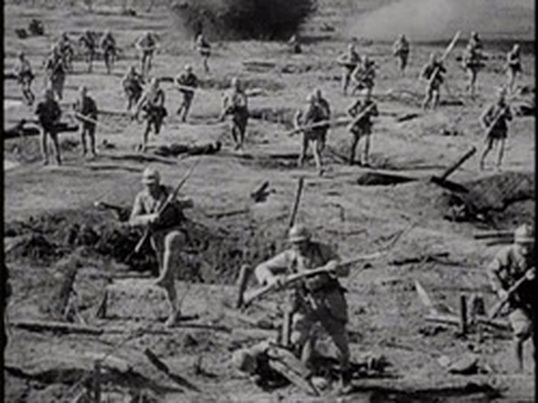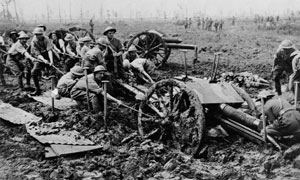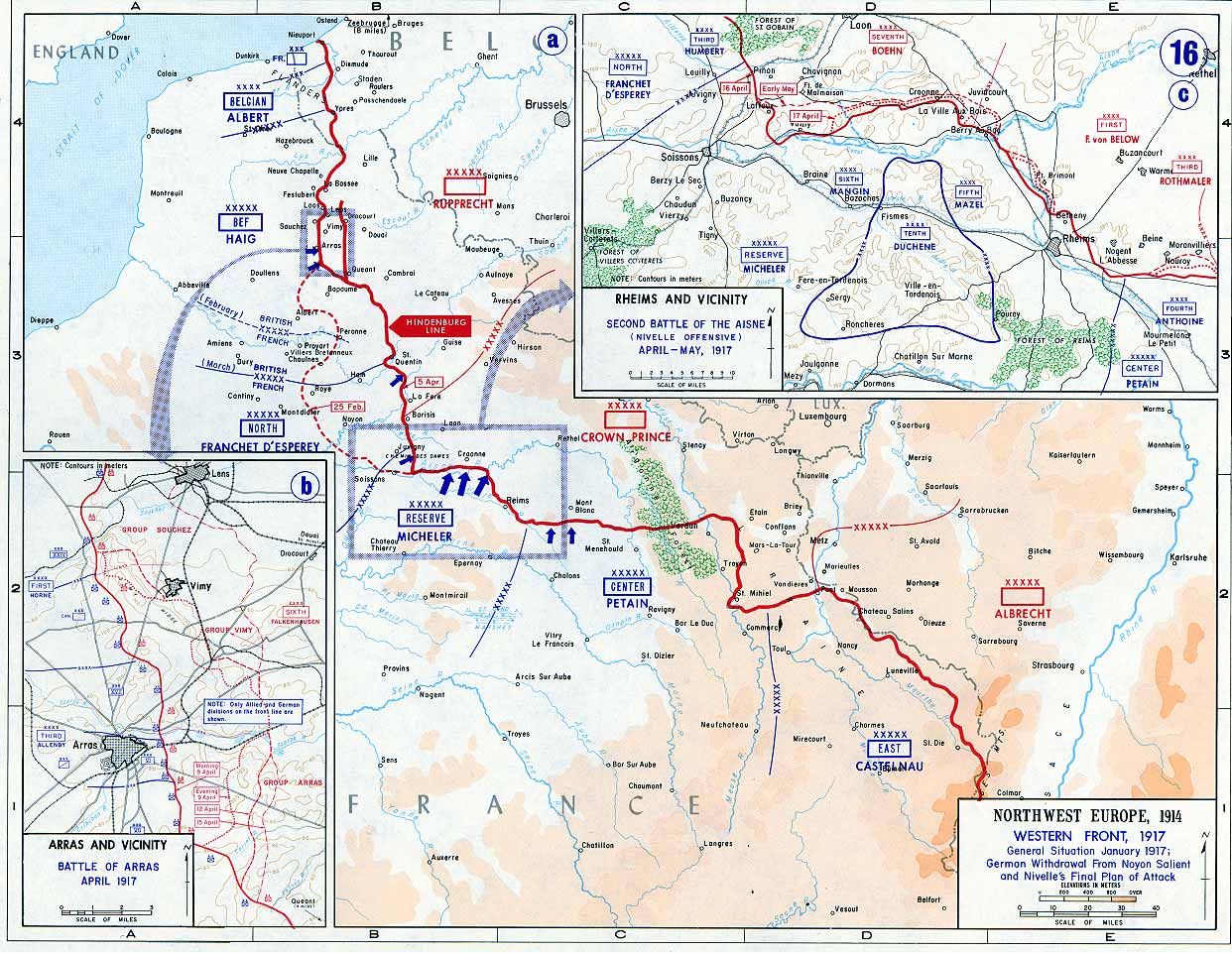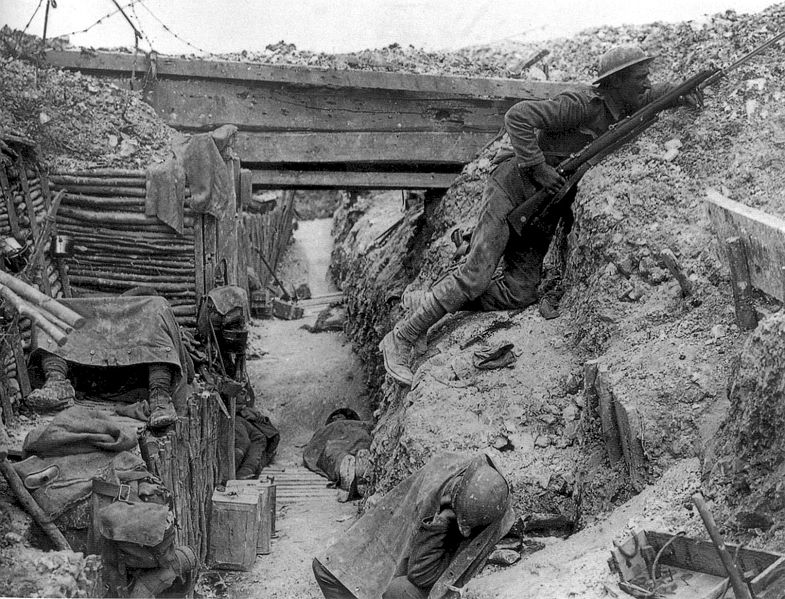THE WESTERN FRONT
The western front was a line of defensive works comprising trenches, barbed wire entanglements, blockhouses and underground shelters. The western front was the most important of the four fronts in WWI. It was the only front where there was fighting throughout the entire war and was where the war ended. The fighting was entirely in French and Belgian territory except for a brief attack into German owned Alsace. Belgium was wholly occupied apart from an enclave situated between Ypres and the French border. No Allied soldier set foot on German soil except for those taken prisoner. Millions of soldiers were sent to the front, where unrelenting artillery shelling on both sides transformed the landscape into craters and desolation, and several million of them perished there after enduring the cold, unhealthy and parasite-ridden conditions of the trenches. Throughout the conflict the various sectors of the front experienced periods of calm punctuated by heavy shelling and bloody offensives.
The western front of the war experienced three phases of fighting. It started as a war of movement with the German offensive, then turned into trench warfare, and then returned to a war of movement in the victorious allied offensive. On the Western Front, in an attempt to drive the German Army from the occupied territories, the Allies succeeded in mobilizing a collective military force comprising more than twenty nations with the British and French providing the majority of the soldiers and resources. The United States, which joined the Allies in the war in the spring of 1917, played a considerable role at the end of the war in the summer of 1918, which saw the Allies victorious.
The German invasion - a war of movement August to October 1914

In the final days of July 1914 countries mobilized their armies at great speed thanks to the efficient railway network then covering mainland Europe and began WWI. The Schliefen plan was the document of the German military strategy in the summer of 1914, which was to quickly defeat France and take Paris, forcing a rapid victory on the Western Front. The plan was a surprise attack through Belgium and into France, and executed by a large force of infantry, cavalry and artillery, while at the same time neutralizing the French initiatives on the Franco-German border. On 4 August 1914, forty-four German divisions streamed through Belgium in an attempt to attack the rear of the French Army massed in the north-east of the country. However despite the surprise, and at great human cost, the French Army withstood the attack and was able to retreat without collapsing. In September 1914 the French were able to finally halt the German offensive just forty kilometers from their capital . Then on September 9, the Germans withdrew sixty kilometers to form a defensive line along the Aisne River. This retreat saw the failure of the Schlieffen plan and the start of trench warfare.
Trench warfare - November 1914 to March 1918
After massive casualties on both sides from the invasion, the two sides took up position behind a continuous line of trenches and defensive works. The French objective became to reclaim, at any human cost, the territory occupied by the Germans. The commanders in chief of the Allied armies on the Western Front, Marshal Joffre for the French and Field Marshal French and General Haig for the British, decided a war of attrition was the way to beat the Germans. This strategy resulted in series of attacks with varying amounts of troops on sections of the front. These attacks were devastating to resources and brought massive losses to the armies. Neither side was able to get any real progress or break through the defensive lines fully
The Allied Victory - the return to a war of movement March-November 1918
 At the end of 1917 the Germans created a new offensive plan called Kaiserschlacht. Ludendorff aimed to break through the Allied lines and advance to the
Channel in order to seize the ports used by the British before American
reinforcements arrived in any great number. This would have put Germany
in a strong position to negotiate favourable conditions for the
termination of the war. The major German offensive began at dawn on 21 March 1918 and devastated the British. The Germans broke through the front and British losses were high. French and American forces finally brought the German thrust to a halt in May 1918. At the end of July the British, French, and Americans were able to push the front in the other direction in a combined counter-attack. On 8 August 1918 the Allies began a massive offensive along the entire front. This
offensive ended in victory for the Allies after 100 days of fighting. The Germans signed the Armistice on November 11, ending WWI.
At the end of 1917 the Germans created a new offensive plan called Kaiserschlacht. Ludendorff aimed to break through the Allied lines and advance to the
Channel in order to seize the ports used by the British before American
reinforcements arrived in any great number. This would have put Germany
in a strong position to negotiate favourable conditions for the
termination of the war. The major German offensive began at dawn on 21 March 1918 and devastated the British. The Germans broke through the front and British losses were high. French and American forces finally brought the German thrust to a halt in May 1918. At the end of July the British, French, and Americans were able to push the front in the other direction in a combined counter-attack. On 8 August 1918 the Allies began a massive offensive along the entire front. This
offensive ended in victory for the Allies after 100 days of fighting. The Germans signed the Armistice on November 11, ending WWI. Works Cited
LE MANER, Yves. "Overview of the war on the Western Front." Remembrance Trails.
N.p., n.d. Web. 1 Apr. 2015.
WW1 - Episode 2: The Western Front. YouTube. N.p., 13 Aug. 2014. Web. 1 Apr.
2015. <https://www.youtube.com/watch?v=Lngt0K9fFnI>.
Pictures
Cheshire Regiment trench Somme 1916. N.d. wikia. Web. 1 Apr. 2015.
<http://img3.wikia.nocookie.net/__cb20100502195158/althistory/images/f/fa/
Cheshire_Regiment_trench_Somme_1916.jpg>.
633620096. N.d. australianidentity. Web. 1 Apr. 2015.
<http://australianidentity2012.weebly.com/uploads/1/2/9/0/12904556/
633620096.jpg?539>.
WesternFront Corbis300. N.d. guim. Web. 1 Apr. 2015.
<http://static.guim.co.uk/sys-images/Guardian/Pix/pictures/2008/11/08/
WesternFront_Corbis300.jpg>.
Western Front 1917. N.d. Wikipedia. Web. 1 Apr. 2015.
<http://upload.wikimedia.org/wikipedia/commons/d/d0/
Western_Front_1917.jpg>.


No comments:
Post a Comment